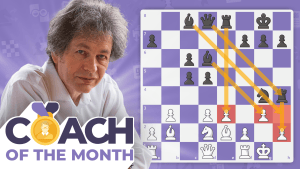
10 Fastest Checkmates
Learning basic checkmates is one of the most important things a chess player can do when starting their journey through the magnificent labyrinth of chess. By learning the following checkmates, you can avoid some quick losses and maybe even notch some quick wins yourself!
Whether you are a beginner, advanced beginner, or intermediate player, these 10 checkmates are extremely important to know. Don't catch yourself on the wrong side of these checkmating patterns, which all result in checkmate in eight moves or less.
Here are 10 of the fastest checkmates:
- Fool's Mate
- Grob's Attack (Fool's Mate Pattern)
- Scholar's Mate
- Dutch Defense (Fool's Mate Pattern)
- Bird's Opening (Fool's Mate Pattern)
- Caro-Kann Defense Smothered Mate
- Italian Game Smothered Mate
- Owen's Defense (Fool's Mate Pattern)
- Englund Gambit Mate
- Budapest Defense Smothered Mate
- Conclusion
Fool's Mate
Fool's Mate is the fastest checkmate possible in chess, and it occurs after only two moves! Don't worry, you can't be forced into this checkmate unless you make two bad moves in a row.
Here is Fool's mate in action:
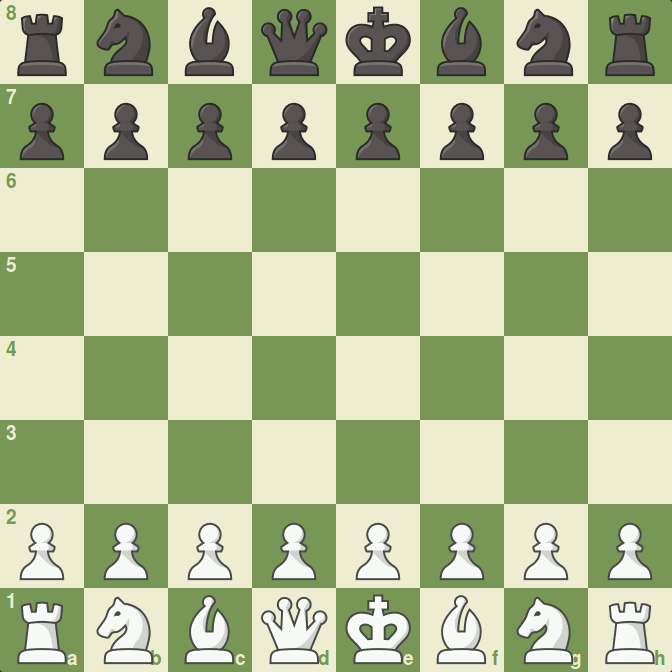
In order for Fool's mate to be performed, White must move their g-pawn up two squares and their f-pawn up one or two squares in the first two consecutive moves. These two moves fatally weaken the e1-h4 diagonal, which Black can move their queen to after moving their e-pawn on the first move.
This is called Fool's mate for a reason—White must make two foolish moves in a row in order for Black to conduct this checkmate.
Some of you may be wondering if this same mating pattern can be used with the white pieces, and the answer is "yes!" Black can lose in an identical fashion to Fool's Mate, but it takes an extra move. If Black moves their f-pawn up one or two squares and then moves their g-pawn up two squares, White can deliver checkmate on move three in what could be referred to as the "Reversed Fool's Mate":
So how can one avoid Fool's mate? All you have to do is keep your f-pawn on f2 (or f7) at the beginning of the game. Before a game even begins, the squares f2 and f7 are the weakest squares on the chessboard because they are only protected by the king. If you move your f-pawn early, you are only inviting dangerous attacks!
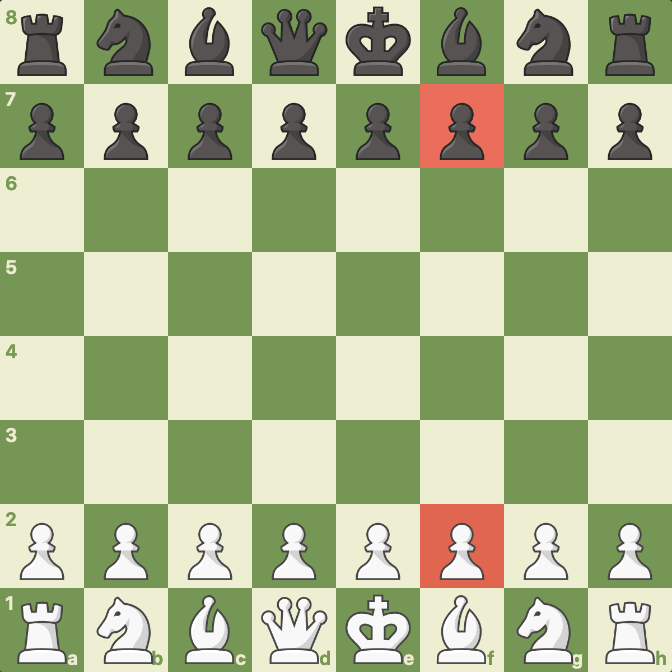
Grob's Attack (Fool's Mate Pattern)
Grob's Attack is an offbeat opening that isn't very popular but has some devoted followers. It begins with 1.g4:

White's normal plan in this opening is to fianchetto the light-squared bishop to g2, where it will have strong influence on the h1-a8 diagonal. Just like in any opening, a singular lapse in the early moves can spell doom.
Grob's attack is one of the few openings that can allow Fool's Mate on move two if White misplays. This checkmate could have been easily avoided if White had played the normal Grob's attack move 2.Bg2—the checkmate above is just another reminder to keep your f-pawn at home at the beginning of the game.
If you are going to move your g-pawn early to fianchetto your light-squared bishop, maybe try moving your g-pawn to g3 instead of the g4 square. We will be seeing the Fool's Mate pattern more in this article.
Scholar's Mate
Scholar's Mate is usually one of the first checkmates that players learn or experience. The concept is simple: White targets the f7-square with both their queen and bishop early, in hopes of delivering checkmate in four moves.
Here is Scholar's Mate in action:
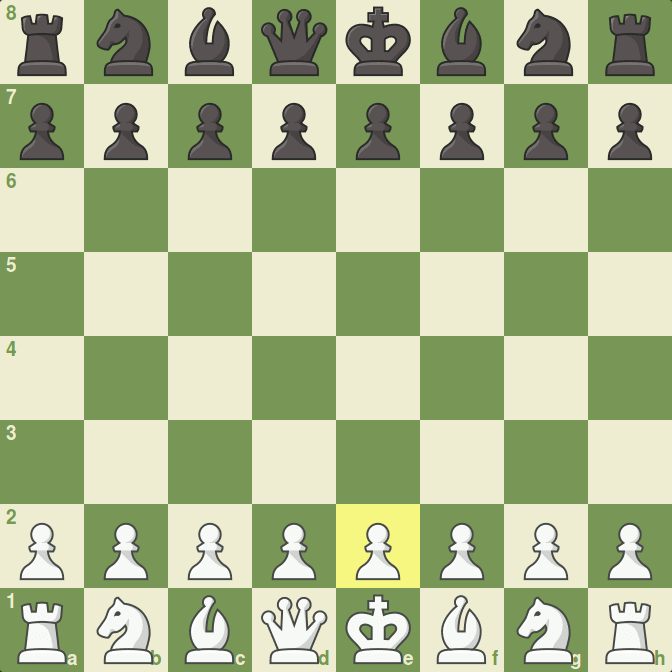
In order to perform this checkmate, you must start with 1.e4. This allows both the light-squared bishop and queen to develop on the following moves. After 1.e4, White can develop the queen or the bishop. The bishop will always arrive at the c4-square, as it targets f7 from this square. The queen can go to either h5 or f3 to target the f7-square.
How can you defend against Scholar's mate? Once White has attacked the f7-square with their queen, you simply defend the f7 square with Qe7 or Qf6 or block the queen's attack with g7-g6 (if White's queen is on h5).

Watch this great video lesson on Scholar's Mate if you'd like to learn more.
Dutch Defense (Fool's Mate Pattern)
The Dutch Defense is an offbeat opening choice but it is employed by players at all levels, from beginners to grandmasters. There are more than a couple of fast checkmates to know in this opening, including the five-move mate below. The Dutch Defense begins with 1...f5 in response to 1.d4:
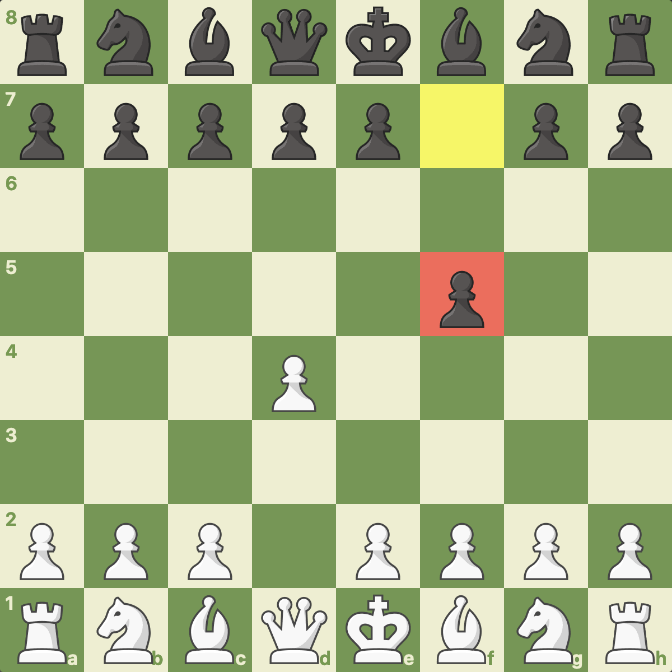
As you can see, 1...f5 takes control of the e4-square early but weakens Black's kingside. If Black is not careful then they can get checkmated early, here is one example:
Just like we saw in the Fool's Mate section, if a player moves their f-pawn early (which is done on move one in the Dutch) as well as their g-pawn, then they are asking for trouble!
Bird's Opening (Fool's Mate Pattern)
Bird's Opening begins with 1.f4, which takes space in the center and controls the e5-square. Unfortunately, this move also weakens White's kingside:
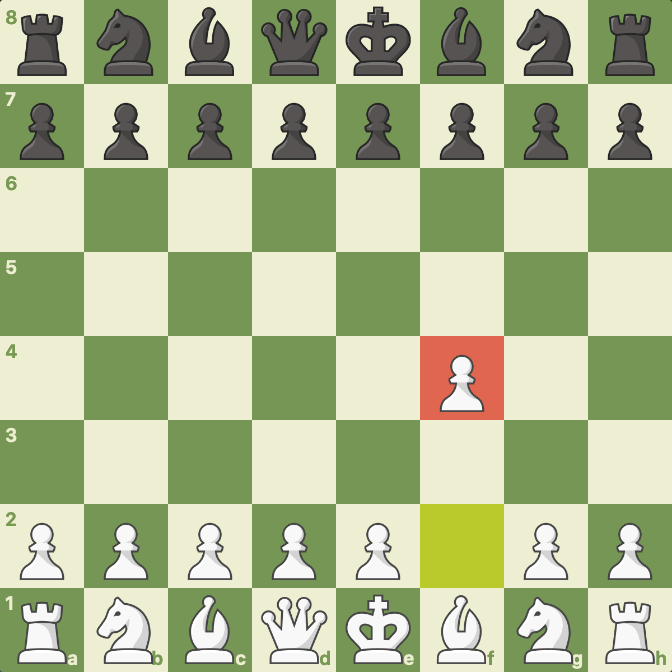
As we have learned many times now, moving the f-pawn early in the opening is a dangerous idea. If Black is aware of Fool's Mate and isn't afraid to gambit a pawn in the opening, then this awesome queen sacrifice checkmate can occur in only six moves:
Caro-Kann Defense Smothered Mate
The Caro-Kann Defense is known as one of the most solid openings that Black can play. However, even in this solid opening, there are quick checkmates to be aware of. The Caro-Kann Defense begins after 1.e4 c6 2.d4 d5:

As you can see, Black has supported the d5 pawn push with 1...c6, and now has a strong presence in the center. All chess players must always be vigilant, regardless of the openings they play. In this particular six-move checkmate, Black failed to be alert at the key moment and we see our first example of a smothered mate:
The first time a player sees this checkmating pattern it leaves a long-lasting impression, and for good reason. We will see this smothered mate theme a couple of more times in this article. The thing to keep in mind about these early smothered mates is to always be alert when an enemy queen is lined up against your king. Black could have avoided this quick checkmate by playing 5...Ndf6, 5...Qc7, 5...e6, or any other move that gave their king some breathing room.
Italian Game Smothered Mate
Staying on the same theme of smothered mate, we will now examine a seven-move smothered mate that occurs in the Italian game. The Italian is a very popular opening at all levels and begins after 1.e4 e5 2.Nf3 Nc6 3.Bc4:
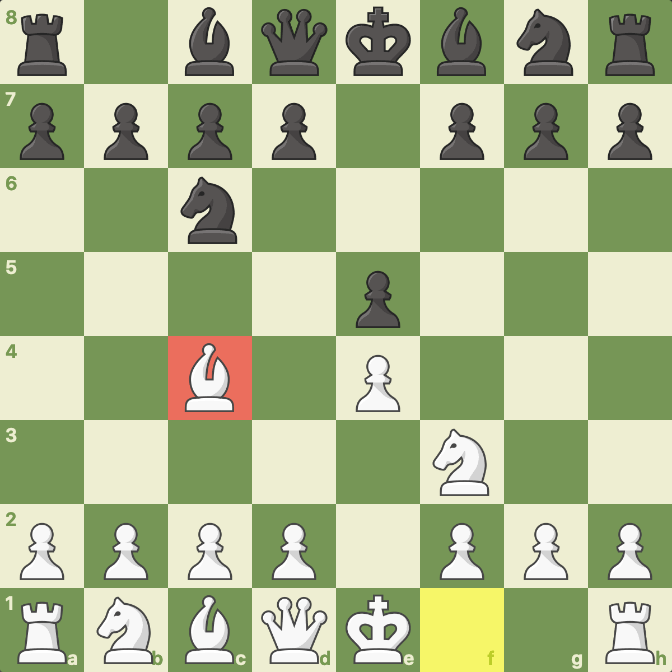
As we found out in the Caro-Kann section above, there are early checkmates in well-known openings and not just offbeat or possibly unsound openings like Grob's attack or Bird's Opening! Check out this wonderful smothered mate in the Italian opening:
7...Nf3# is a beautiful winning stroke that delivers checkmate, similar to 6.Nd6# in the Caro-Kann smothered mate. White had to make a couple of mistakes to lose this game so quickly, 4.Nxd4 would have avoided all of the complications. Whether you play 1.e4 as White or 1...e5 as Black, this checkmate is incredibly important to be aware of!
Owen's Defense (Fool's Mate Pattern)
Owen's Defense is another offbeat opening that can have the Fool's Mate checkmating pattern. It aims to fianchetto the light-squared bishop quickly:
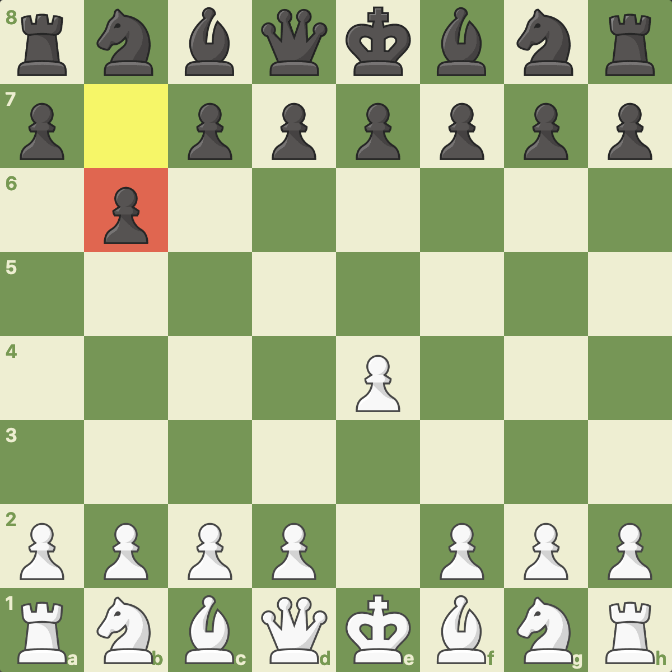
You may be asking yourself, "How can the Fool's Mate checkmating pattern happen from this position?" Check out the game below to see a beautiful queen sacrifice checkmate. This game was won by Gioachino Greco in 1619!
Similar to the queen sacrifice checkmate using the Fool's Mate pattern that we saw in the Bird's Opening section, this checkmate from the 17th century should leave an impression. The moral of the story? Don't move your f-pawn too early in the opening!
Englund Gambit Mate
The Englund Gambit is another offbeat opening, but it is popular at the club level. Black immediately challenges the d4 pawn, after 1.d4 e5:
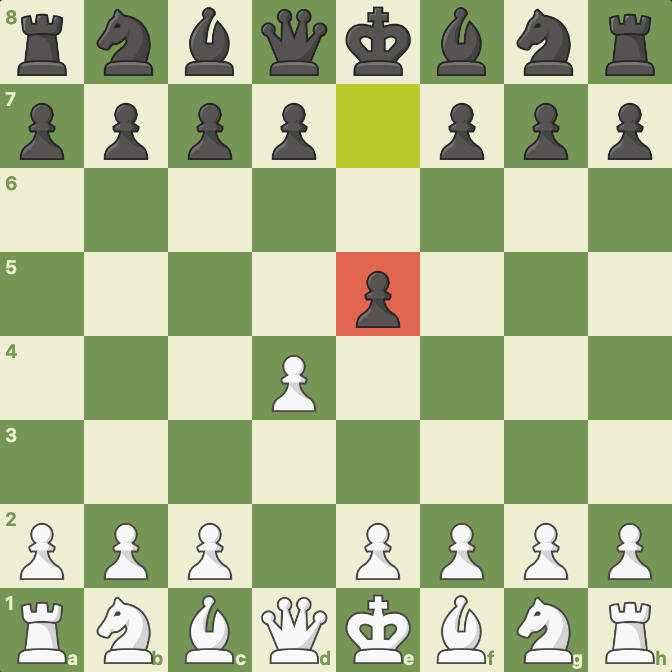
This is an opening that contains a lot of traps. If you are a tactical player who likes tricks, you should check out the Englund Gambit in Explorer. One of the many tricks in this gambit ends with White getting checkmated in only eight moves:
I can't think of a faster way to checkmated on the back rank! White had to make a few large mistakes to allow this specific checkmate, 6.Nc3 is a natural and strong move that gives White a large lead in development. Another way to avoid all of these types of positions as White is to simply return the pawn while maintaining your lead in development after 4. Nc3 Nxe5 5.e4. If you want to get tricky with the white pieces against the Englund Gambit, you can try 4.Nc3 Nxe5 5.Nd5!
Budapest Defense Smothered Mate
The Budapest Defense is similar to the Englund Gambit as it also has a quick e7-e5 pawn push. It starts with 1.d4 Nf6 2.c4 e5:
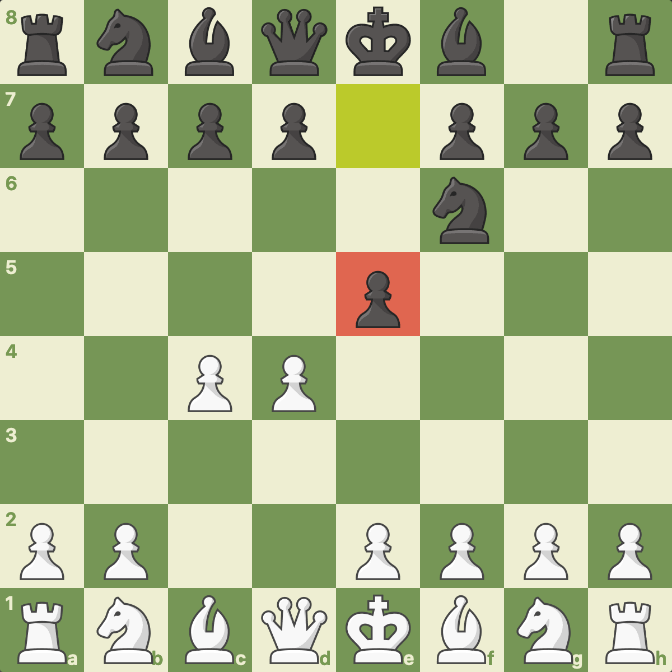
As you can see, the Budapest Defense challenges White's d-pawn very quickly—the only difference between this starting position and the Englund Gambit are the inclusions of c2-c4 for White and Ng8-f6 for Black. Unlike the Englund Gambit back-rank checkmate that we saw in the previous section, this checkmate is another great example of a smothered mate:
Another smothered mate! In this game, White only made one mistake (capturing the bishop with 8.axb4??). Instead of the continuation in the game, White could have avoided this checkmate by playing 7.e3 (stopping the eventual Nd3#), or by playing a different eighth move: 8.Nxe5, 8.Bxe5, and 8.e3 all look fine for White.
Conclusion
So there you have it—ten of the fastest checkmates in chess! We saw some recurring patterns and themes (e.g. the Fool's Mate pattern, smothered mates, quick attacks on the f2/f7 squares) which should all be learned so you can avoid quick defeats but also so you can earn a quick victory if given the opportunity. I hope you found this article both fun and entertaining, and remember to keep your f-pawn at home early in the game!
Which fast checkmate is your favorite? Let us know in the comments below!
Signing up for Chess.com is free and easy, so what are you waiting for?

